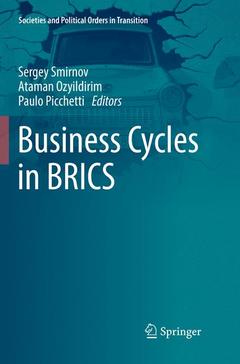Business Cycles in BRICS, 1st ed. 2019 Societies and Political Orders in Transition Series
Langue : Anglais
Coordonnateurs : Smirnov Sergey, Ozyildirim Ataman, Picchetti Paulo

This volume focuses on the analysis and measurement of business cycles in Brazil, Russia, India, China and South Africa (BRICS). Divided into five parts, it begins with an overview of the main concepts and problems involved in monitoring and forecasting business cycles. Then it highlights the role of BRICS in the global economy and explores the interrelatedness of business cycles within BRICS. In turn, part two provides studies on the historical development of business cycles in the individual BRICS countries and describes the driving forces behind those cycles. Parts three and four present national business tendency surveys and composite cyclical indices for real-time monitoring and forecasting of various BRICS economies, while the final part discusses how the lessons learned in the BRICS countries can be used for the analysis of business cycles and their socio-political consequences in other emerging countries.
1. Introduction. Part I. The Global Economy and BRICS.- 2. BRICS in the Global Economy.- 3. Institutions, Productivity Change and Growth.- 4. The Connectedness of Business Cycles between the BRICS.- Part II. History and Driving Forces of Economic Cycles in BRICS.- 5. Economic Cycles in Brazil.- 6. Economic Fluctuations and Their Drivers in Russia.- 7. Business Cycle Measurement in India.- 8. Economic Cycles and Crises in New China.- 9. China’s Economic Cycles: Characteristics and Determinant Factors.- 10. A Brief History of Business Cycle Measurement in South Africa.- Part III. Business Tendency Surveys (BTSs) in BRICS.- 11. International Tradition of Tendency Surveys.- 12. Economic Tendency Surveys in Brazil: Main Features and Uses.- 13. Russian Business Tendency Surveys by HSE and Rosstat.- 14. Business Tendency Surveys in India.- 15. Business Tendency Surveys in China.- 16. South Africa: The BER’s Business Tendency Surveys.- Part IV. Composite Cyclical Indicators for Real-Time Monitoring and Forecasting the BRICS Economies.- 17. Compiling Cyclical Composite Indexes: The Conference Board Indicators Approach.- 18. Coincident and Leading Indicators for Brazilian Cycles.- 19. Brazilian Business Cycles as Characterized by CODACE.- 20. A Bayesian Approach to Predicting Cycles Using Composite Indicators.- 21. A Survey of Composite Leading Indices for Russia.- 22. Indices of Regional Economic Activity for Russia.- 23. An Application of the Indicator Approach to Developing Coincident and Leading Economic Indexes for India.- 24. Business Climate Indices in China.- 25. Tracking Business and Growth Cycles in the Chinese Economy Using Composite Indexes.- 26. The SARB’s Composite Business Cycle Indicators.- 27. Alternative Cycle Indicators for the South African Business Cycle.- 28. Forecasting Business Cycles in South Africa.- Part V. Concluding remarks. 29. Measurement, Monitoring, and Forecasting Economic Cycles: BRICS Lessons.
Sergey Smirnov is Deputy Director of the “Development Center” Institute, National Research University Higher School of Economics, Moskow. For decades he worked in academic institutions and private think-tanks. In recent years, he focusses on monitoring and analyzing the Russian and international economy and pays special attention to the characteristics of the Russian economic cycle, building up this field of economic knowledge almost from the ground upwards. His research established the long-run historical trajectory of the Russian economy, identified its turning points, constructed a system of cyclical (leading, coinciding, and lagging) indicators for Russia and assessed its suitability for forecasting of the two latest recessions in real-time. He received his PhD in economics from The Moscow State University in 1986.
Ataman Ozyildirim is Director, Business Cycle and Growth Research at The Conference Board, New York. In addition toleading the research program on business cycles and developing leading economic indexes for mature and emerging economies, he also manages the research program in productivity, innovation and competitiveness. His team produces The Conference Board’s annual Global Economic Outlook which is also updated quarterly. As a native of Istanbul, Turkey, he received his BA in economics from Ithaca College, New York and his PhD in economics from The Pennsylvania State University.
Focuses on the analysis and measurement of business cycles in BRICS Explores the interrelatedness of business cycles within BRICS Presents cyclical indicators for real-time monitoring economies in BRICS Discusses the socio-political consequences of business cycles
Date de parution : 02-2019
Ouvrage de 513 p.
15.5x23.5 cm
Disponible chez l'éditeur (délai d'approvisionnement : 15 jours).
Prix indicatif 158,24 €
Ajouter au panierDate de parution : 08-2018
Ouvrage de 513 p.
15.5x23.5 cm
Thèmes de Business Cycles in BRICS :
© 2024 LAVOISIER S.A.S.



